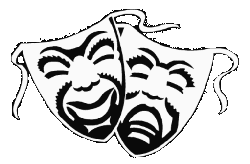

|
Photo Gallery Archive
|
Windows and Mirrors
Halifax West Student Production
The Bella Rose Arts Centre
Halifax, Nova Scotia
June, 2012
(All lights are 1000 watts unless noted.
All fresnels and ellipsoidals are 150mm.)
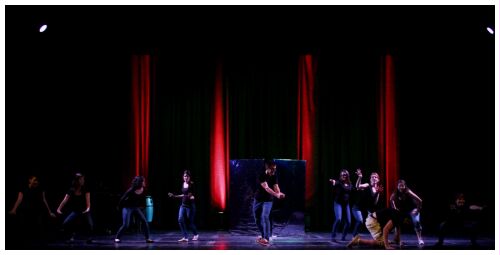 A slight flesh wash lights the dancers' faces from the front of house (FOH) using two PAR 64 Wide Floods in short-throw fixtures. The side wash in violet also uses PAR 64 Wide Floods, but there are four, two of which can be seen in the upper corners of the photo. Columns of red up light the rear black curtain using four 600-watt, PAR 64 Raylights. The latter are not properly positioned here, nor do the side lavenders cover the extreme left and right, because this photo was taken during a rehearsal before a final focus was done. |
 In this close view, a dark blue wash from the front is contrasted by an upstage aqua wash from three fresnels on the rear catwalk. Four Medium Flood PAR 64s wash the downstage in a medium pink. These are near the upstage corners. Note the nice separation of the colours from behind. |
 The same lighting as in the previous image is seen here except that a followspot highlights the principals. |
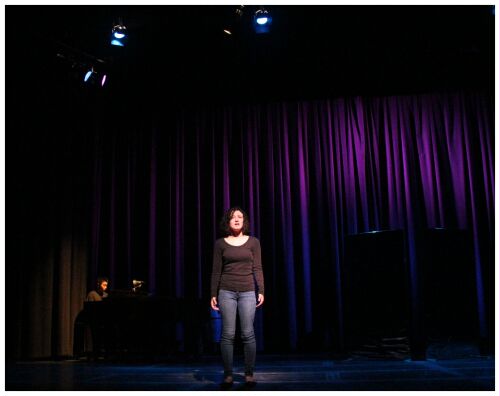 No front wash is used in this low-angle shot. The singer is lit by a followspot and back/top lit from four fresnels in medium blue, two of which can be seen above her sporting barndoors. The piano player is lit in straw by a 26-degree ellipsoidal, which is the second light from your right. Finally, the curtain has medium lavender and dark blue done by PAR 64 Narrow Spots, two per colour. Their side position can be seen by the two closely-spaced fixtures at the upper left. |
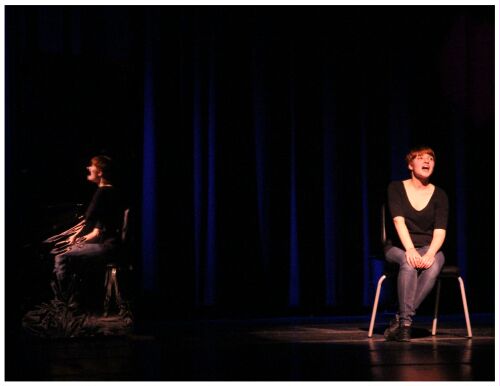 Lighting is ultra simple here. The singer is lit in flesh via a single followspot, while the rear curtain has a dark blue. Notice the wrinkled mirror. This photo was taken in rehearsal before the reflective mylar covering had been fully stretched. |
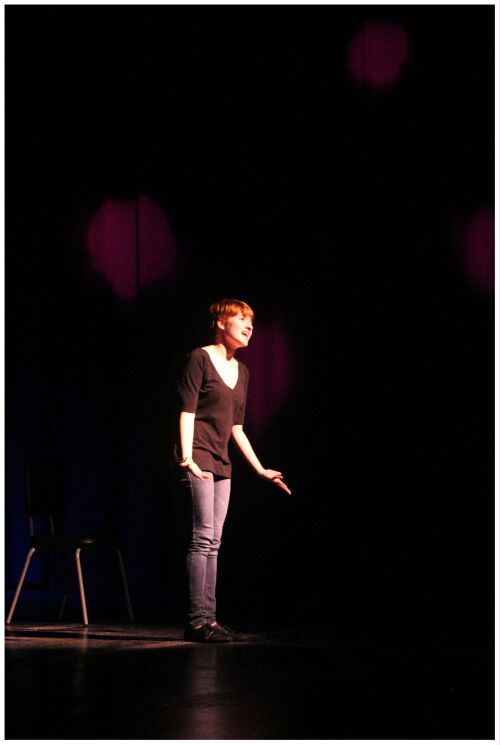 Continuing from above, the singer is still lit by a followspot but has stood and moved downstage. The dots of light are done with four 37-degree ellipsoidals using beam splitter patterns producing a total of twelve dots. Four are seen here; all are coloured in dark magenta. |
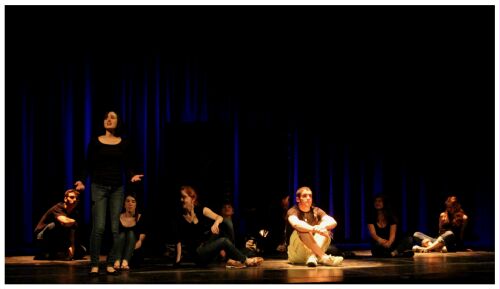 The dark blue slashing the rear curtain silhouettes the mirrors well. Three downlights in an apricot colour project pools of patterned light on to three of the actors. The latter use 26-degree ellipsoidals. A flesh wash then provides general front lighting for all the performers. |
Inherit the Wind
Dartmouth Players
Dartmouth, Nova Scotia
May, 2012
The lighting design for this production was shared by
Andrew Finnigan and Richard Bonner. Although each made
suggestions to the other, Andrew mostly designed the
street scenes, while Richard concentrated on the courtroom.
(All lights are 500 watts unless noted.
All fresnels have barndoors.)
 This is one of Andrew's street looks. It consists of front-of-house and upstage light-blue washes to represent daylight. Off to the right behind the organ grinder is a pattern projection of a stone wall. That is done using a 750-watt, 115mm ellipsoidal. |
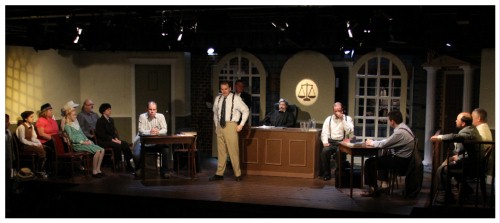 To make this appear as early evening in the courtroom, a window pattern is projected on to the wall above the gallery in a sunset yellow. Other exterior lighting comes through the rear windows in a sky blue using 150mm fresnels. This blue is continued througout the scene as seen with the back and top light on the principle characters. Individual main areas are lit using fresnels of either 500-watt 150mm, or 250-watt 80mm. The "Scales of Justice" is painted on the flat but is lit in a round pattern with no colour. An iris in a 750-watt, 115mm ellipsoidal accomplishes that. |
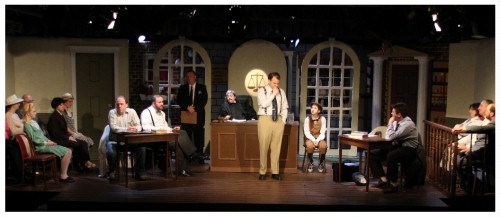 This is the same as above but later in the night. The window pattern is gone and the upstage window blue is dimmer to be more moonlight-like. The gallery and jury box are lit a bit brighter with 500-watt fresnels to suggest that interior courtroom lighting has been switched on. |
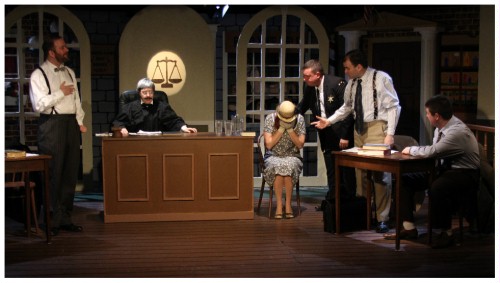 This closer view shows the individual area lighting for the judge's bench, witness stand and defense table. Notice the moonlight coming through the upstage wondows and hitting the floor. To reinforce this, the judge also has a blue top light, as does the defence table. |
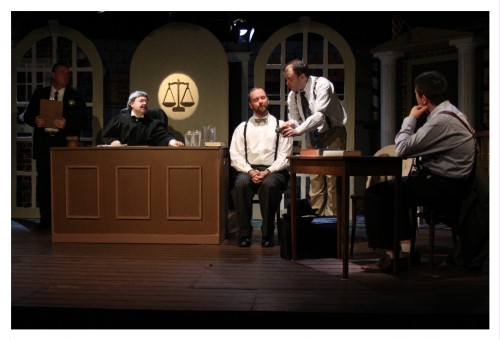 This is the same lighting as above, but seen from a different angle. One of the window lights can be seen above and well behind the witness stand. |
 In this very close-in photo, the lighting on the witness stand is seen. The blue moonlight comes through the window and its colour is echoed as top lighting on the actors. Front lighting is a single 250-watt fresnel. |
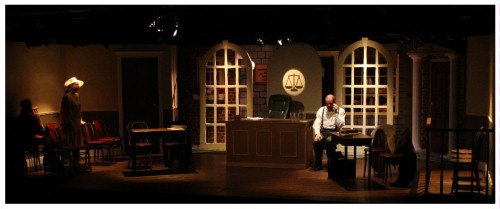 With the exception of the "Scales", the after-hours courtroom lighting is done strictly with downlighting in warm colours. Lights are 250- and 500-watt fresnels, as described in the first courtroom photo. |
Guys and Dolls
Fairview Junior High School
The Bella Rose Arts Centre
Halifax, Nova Scotia
April, 2012
(All lights are 1000 watts unless noted.
All fresnels and ellipsoidals are 150mm.)
 The upstage is lit in a medium blue from the proscenium pipe using two PAR 64, Wide Flood, short-throw fixtures. The cast is also top lit by four fresnels in a contrasting, dark steel blue. Downstage is covered from each side using one each PAR 64 Medium Flood with a straw gel. These are positioned in high angle, front-of-house (FOH) alcoves and although using long-throw fixtures, they have barndoors to additionally control spill. |
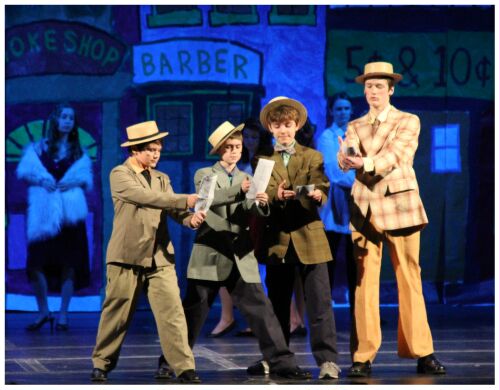 In this closer view, the high-angle FOH wash is clearly seen to well separate the principals from the upstage cast. |
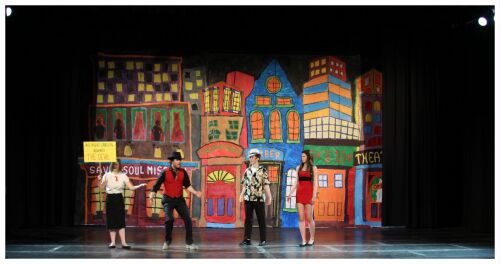 The daytime lighting here and in the next photo is done with two PAR 64 Wide Floods from FOH, and two more for the upstage from the proscenium pipe. All use straw gel. In addition, to have the blue paint show better and not be dulled by a straw tint, two medium blues for the upstage are brought up just enough to take that dullness away. The steel blue back lighting comes from four PAR 64 Medium Floods, two each near each upstage back corner. These can be partially seen at the extreme upper corners of the photo. |
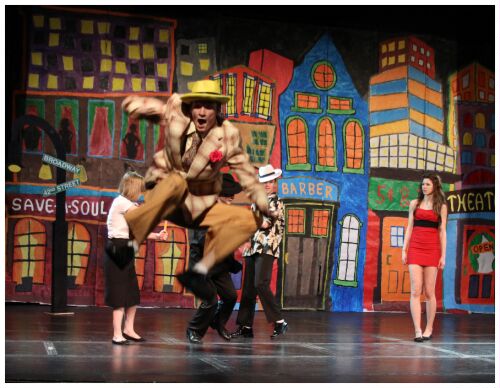 |
 Medium blue front and upstage washes plus a dark steel-blue wash from the top create a night look for the downtown set. To give extra atmosphere, two 37-degree ellipsoidals with breakup patterns and turquoise gel are shone onto the central city buildings. The latter can be better seen in the "Hot Box" photos next. |
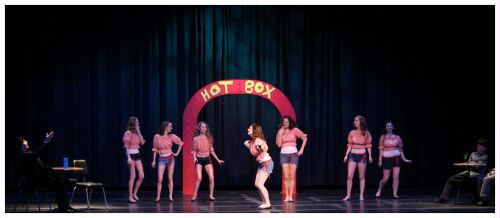 An FOH colour-correction orange washes the stage while the table areas are top lit with one each 500-watt, 35-degree ellipsoidal in the same colour. The back curtain uses those two 37-degree ellipsoidals with breakup patterns and turquoise gel. |
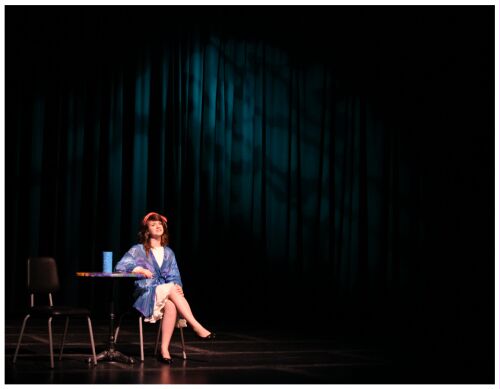 Here is the same lighting but with a flesh-coloured FOH spot substituted for the top light on the stage right table. This was during a rehearsal and the "Hot Box" arch was not in place. |
 A single 25-degree ellipsoidal with a blue colour-correction gel is used from the house catwalk. Note how the light's shutters have been oriented to give an interesting angle pattern on the walls above the cast members. (The light at center right is a venue wall sconce.) |
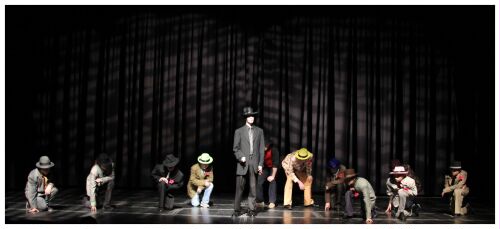 This look is produced by six 37-degree ellipsopidals using slash patterns. Four light the stage from the front (note their effect on the stage-right floor), while two more illuminate the rear curtain from on-stage side positions. A single FOH 19-degree ellipsoidal highlights the central actor. No colour was used in any fixture. |
 Here, a blue wash covers from the front while two FOH 37-degree ellipsoidals light the central table and nearby area in a flesh colour. The off-white curtain is lit in pink and yellow from Narrow Spot PAR 64s positioned off to the sides and a metre or so downstage of that curtain. |
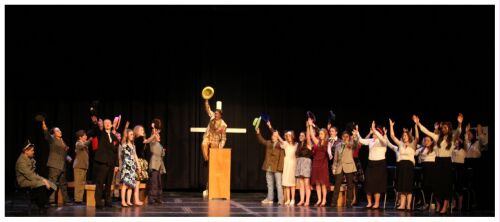 A front wash in colour-correction orange warms the stage for this interior scene. The only other lighting is a top steel blue from four fresnels. |
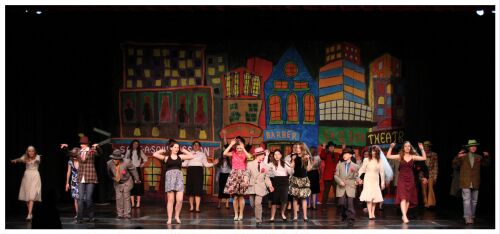 Lighting on the stage and set is in straw with four steel-blue PARs for backlighting, all as described earlier. |
Rent
Halifax West Players
The Bella Rose Arts Centre
Halifax, Nova Scotia
December, 2011
(All lights are 1000 watts unless noted)
All fresnels and ellipsoidals are 150mm.)
 The deep blue upstage lighting comes from the proscenium pipe using two PAR 64, Wide Flood, short-throw fixtures. Notice how only two of these fixtures can easily cover an entire stage width. Front lighting is from the extreme ends of the house catwalk using two PAR 64, Medium Floods in straw. Back lighting on the front principals comes from upstage PAR 64 Medium Floods, one in each extreme corner in front of the scaffolding. They have medium blue gels. The under scaffolding lighting comes from seven rectangular, LED wall-washer fixtures mounted on the floor and set to `Green' at 70%. The tree is lit using standard strings of Christmas lights. |
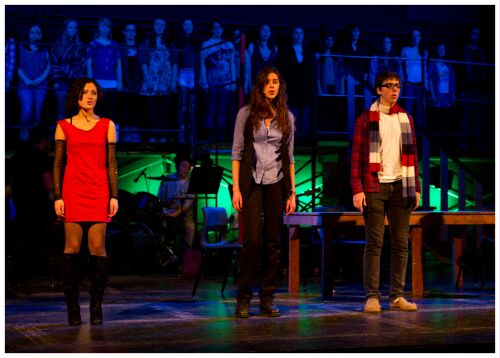 In this closer view, note the excellent separation of colours. |
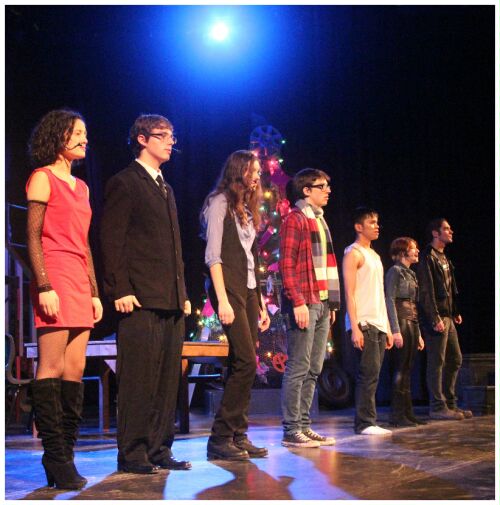 This side angle shows one of the corner back lights. |
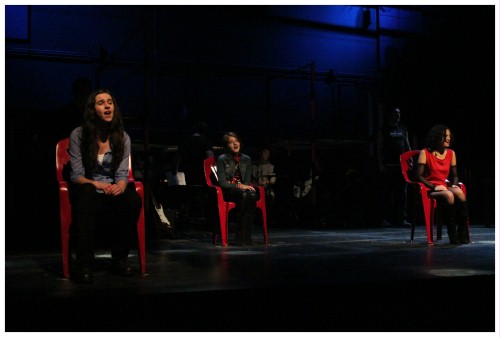 Each chair is lit from the front of house using a single 19-degree, no-colour ellipsoidal. Side lighting comes from four PAR 64, Wide Flood, short-throw fixtures in a colour-correction blue. The splashes of medium blue on the rear wall are done using four 750-watt fresnels, the effect from the two stage left ones being seen here. |
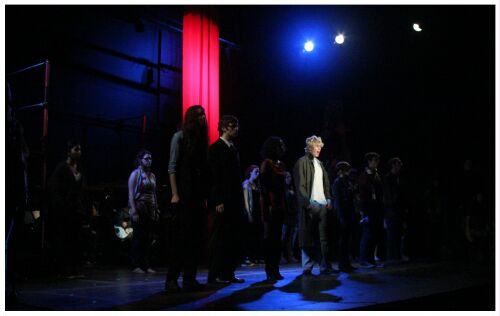 The stage is lit solely from the side and rear, with blue lights on the back wall, all as described in other photos. The flag and an unseen stairway are lit from the proscenium using a 37-degree ellipsoidal in a saturated red. A followspot highlights the center actor. |
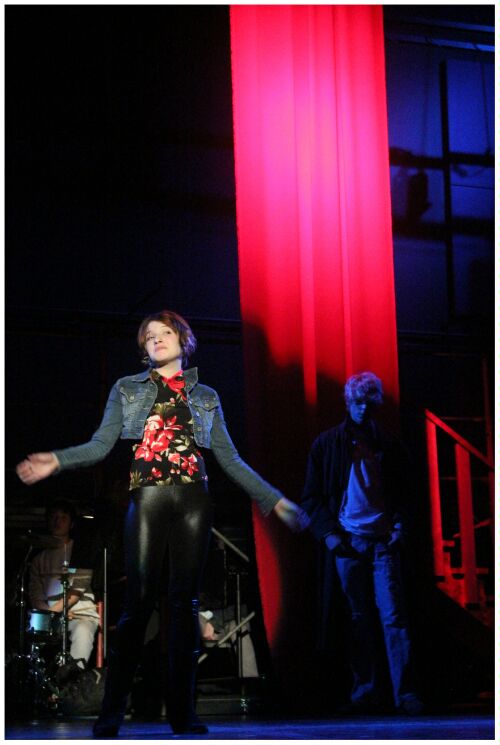 The lighting is as above. Again, a followspot highlights the prominent actor. |
Cabaret
Dartmouth Players
Dartmouth, Nova Scotia
November, 2011
(All lights are 500 watts unless noted.
All fresnels have barndoors.)
 For this interior of the rooming house, Cliff's room is front lit with four, 150 mm fresnels in flesh coupled with diffusion to soften the light. Two more fresnels with barndoors provide backlighting in daylight blue to simulate light through windows from the exterior. |
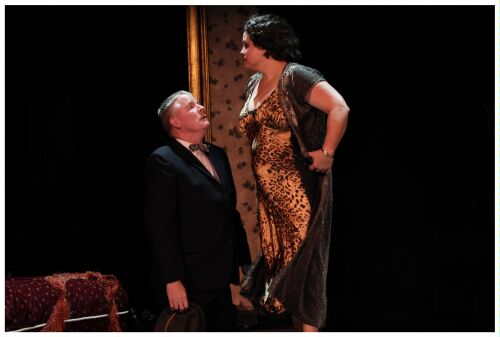 A closeup of the above lighting except this is Schneider's room and so four 80mm, 250-watt fresnels in steel blue have been substituted for the back blues seen above. (See the next photo). |
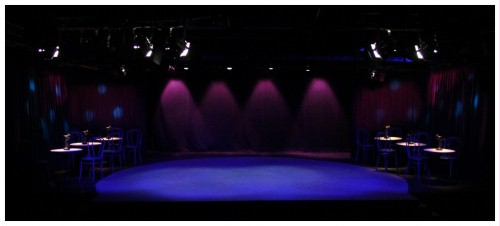 A production shot with no actors shows the basic Kit Kat Klub look. Many of the lights used to make it are visible. Six 150 mm fresnels wash a deep blue onto the stage while more produce pink highlights on the side curtains. Four 250-watt, 80mm fresnels in lighter pink make the triangular patterns on a rear scrim. The combination of looks with lots of dark area increases the contrast and makes that back scrim appear to be much farther upstage than it really is on this small stage. Four more 80mm fresnels back light the centre stage area in steel blue. When coupled with the front blue wash, a two-tone blue is produced on the floor. The turquoise dots are made from six, 115mm ellipsoidals with beam splitters. To complete the look, six more 80mm fresnels shine down in amber using colour-correction orange, one upon each white table top. They represent candlelight. |
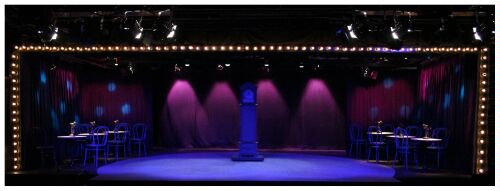 The marque lighting has been added to the above look. It is produced using strips of medium-based sockets up the sides and across the top. The top row has been lowered half a metre to be able to meet the side strips which are limited height-wise due to piping in the theatre. This was also done to increase the apparent width of the stage, much as wide-screen computer monitors do by cutting off the top and bottom of a regular-ratio screen. Lamps chosen were `11-S14' because the bulb shape is reminiscent of similar lamps employed in the 1930s. In addition, clear bulbs were used to give a glistening effect. |
 In this low-angle closeup of the stage-left corner of the Kit Kat Klub, one can see the fixtures used to produce all the effects. Notice how close that back scrim actually is when seen from the stage's edge. The audience, being much farther back, perceives it to be farther away because the lighting tricks the eye. |
 A single followspot made by dropping an iris into a 575-watt, 115-mm ellipsoidal and the blue wash light this scene from the front. Dimmed side pinks and table-top lights complete the look. This and the next shot were taken during rehearsal so full costumes and makeup are not evident. |
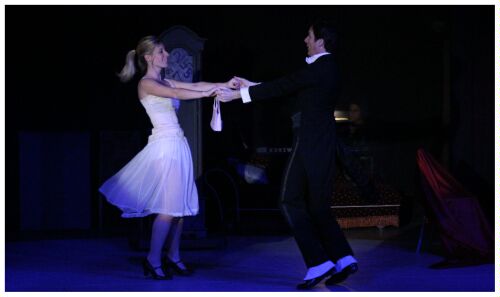 The same lighting as above. The female dancer would actually be wearing a gorilla costume during the production. |
 This musical number was done with the dancers holding LED flashlights for self illumination. These lights give a bluish cast. Scrim and side-curtain pinks were incorporated to complete the look, but are not easily seen by the camera in this or the next two photos because they have been dimmed to very low levels. |
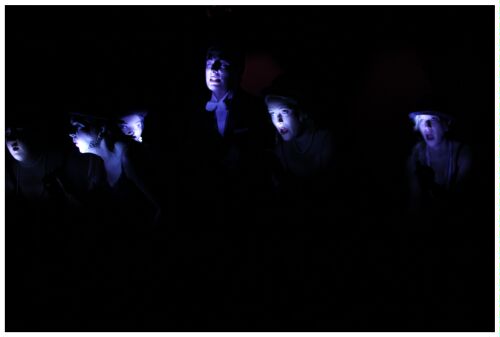 |
 |
 This picture was taken at an early rehearsal. Seen is the musical's director as viewed from on stage. It gives non-performers an idea of the number of front lights that might be on during a given scene. |
Into the Woods
Music Theatre Montreal
DB Clarke Theatre, Montreal
October, 2011
(All lights are 750 watts unless noted.)
 The set consists of doorways at stage level and trees made of slats and wire flown from overhead. The criss-crossing of the slats produces a moire (MORE-ay) effect that creates black patterns in the air where slats pass in front of other slats. The patterns vary from different perspectives, as you will see in the different photos. Lighting for the trees is done with 1000-watt, 150mm fresnels shone straight down and barndoored to hit them where they bulge toward downstage. A sunshine yellow is used to represent sunlight filtering through the trees, and additional down lighting from other fresnels is in red. The rear scrim has 1000-watt, linear cyclorama lights, here in red and green to produce a yellow cast. |
 The lighting is the same as above except that twelve 115mm ellipsoidals from two front-of-house positions spanning the theatre wash the down stage in a straw colour. |
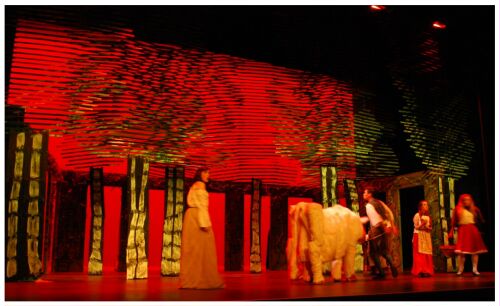 The rear scrim here is washed in red while top fresnels in red down light the stage through the trees. A straw wash from the front of house lights the principals. |
 The only lighting here is a single ellipsoidal on the principals. The scrim lights mix red and blue to produce the lavender seen here. |

|
This is an angle not seen by the audience.
Lighting is from two ellipsoidals from the
front of house. One illuminates the window surround
while another from cross theatre shines directly
on the actress. A 1000-watt, 150mm fresnel glows
amber on the wall behind to better define her.
Not seen in the photo is steel blue lighting that
shines on the lower brickwork under the window.
|
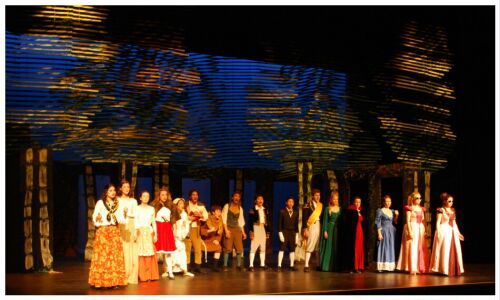 Blue Scrim lighting contrasts nicely with the sparse tree lighting and full wash on the cast. |
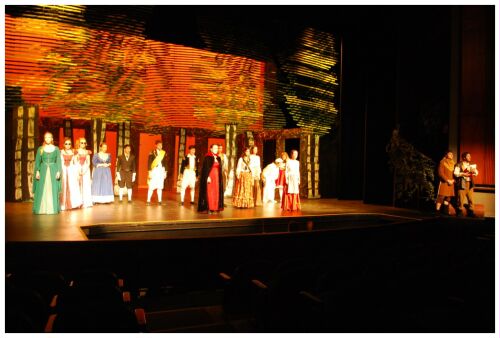 Seen here is a wider-angle shot taken during rehearsal. Shown are the stage, cast and set with the orchestra pit below. To the right is a ramp leading from the house to stage left upon which some of the action happened. It is lit in a straw colour by one FOH ellipsoidal. |
|
Thank you to photographers Helen Doane and Bruce Goodick of Halifax,
and Peter Davoust of Montreal for usage of their photos. |
|
Return to the |
Return to the |
|
Go to the |
|